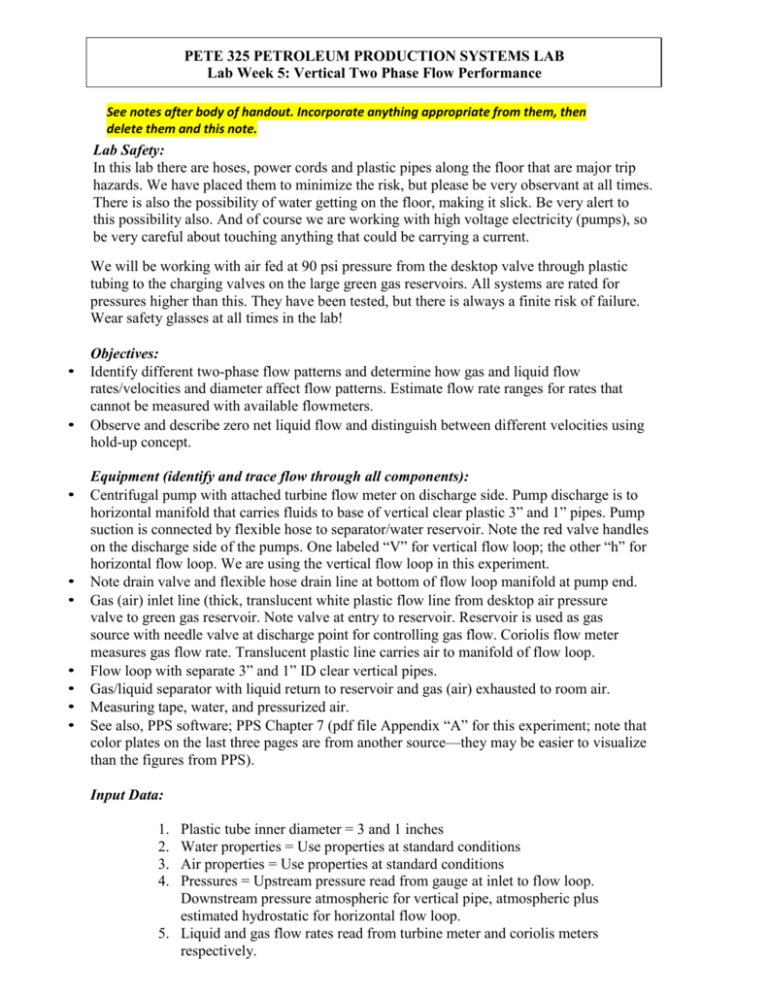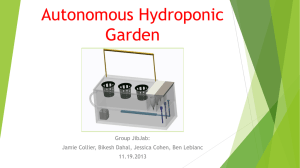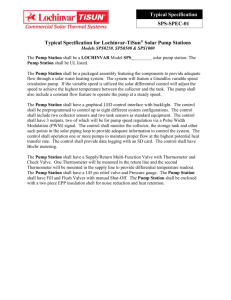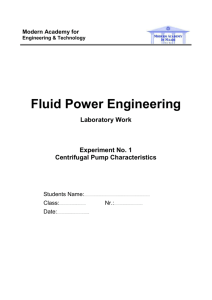Week 5 Lab Handout - Vertical Two Phase Flow
advertisement

PETE 325 PETROLEUM PRODUCTION SYSTEMS LAB Lab Week 5: Vertical Two Phase Flow Performance See notes after body of handout. Incorporate anything appropriate from them, then delete them and this note. Lab Safety: In this lab there are hoses, power cords and plastic pipes along the floor that are major trip hazards. We have placed them to minimize the risk, but please be very observant at all times. There is also the possibility of water getting on the floor, making it slick. Be very alert to this possibility also. And of course we are working with high voltage electricity (pumps), so be very careful about touching anything that could be carrying a current. We will be working with air fed at 90 psi pressure from the desktop valve through plastic tubing to the charging valves on the large green gas reservoirs. All systems are rated for pressures higher than this. They have been tested, but there is always a finite risk of failure. Wear safety glasses at all times in the lab! • • • • • • • • • Objectives: Identify different two-phase flow patterns and determine how gas and liquid flow rates/velocities and diameter affect flow patterns. Estimate flow rate ranges for rates that cannot be measured with available flowmeters. Observe and describe zero net liquid flow and distinguish between different velocities using hold-up concept. Equipment (identify and trace flow through all components): Centrifugal pump with attached turbine flow meter on discharge side. Pump discharge is to horizontal manifold that carries fluids to base of vertical clear plastic 3” and 1” pipes. Pump suction is connected by flexible hose to separator/water reservoir. Note the red valve handles on the discharge side of the pumps. One labeled “V” for vertical flow loop; the other “h” for horizontal flow loop. We are using the vertical flow loop in this experiment. Note drain valve and flexible hose drain line at bottom of flow loop manifold at pump end. Gas (air) inlet line (thick, translucent white plastic flow line from desktop air pressure valve to green gas reservoir. Note valve at entry to reservoir. Reservoir is used as gas source with needle valve at discharge point for controlling gas flow. Coriolis flow meter measures gas flow rate. Translucent plastic line carries air to manifold of flow loop. Flow loop with separate 3” and 1” ID clear vertical pipes. Gas/liquid separator with liquid return to reservoir and gas (air) exhausted to room air. Measuring tape, water, and pressurized air. See also, PPS software; PPS Chapter 7 (pdf file Appendix “A” for this experiment; note that color plates on the last three pages are from another source—they may be easier to visualize than the figures from PPS). Input Data: 1. 2. 3. 4. Plastic tube inner diameter = 3 and 1 inches Water properties = Use properties at standard conditions Air properties = Use properties at standard conditions Pressures = Upstream pressure read from gauge at inlet to flow loop. Downstream pressure atmospheric for vertical pipe, atmospheric plus estimated hydrostatic for horizontal flow loop. 5. Liquid and gas flow rates read from turbine meter and coriolis meters respectively. Two-Phase Flow Regimes and Zero Net Liquid Flow (ZNLF) Before you begin the experiments: Carefully observe the liquid and gas flow apparatus. Trace and identify gas flow components, including main gas inlet, gas reservoir, flow path, valves, Coriolis flow meter, gas-liquid separator, gas discharge port. Trace and identify components of the liquid flow path, including water reservoir, pump, flow meter, separator, return path, drain line and valve. Procedure: Make sure air discharge needle valve at top of gas reservoir (green tank) is closed. Open fill valve at bottom of gas reservoir. Turn on air master valve on desktop, and fill the gas reservoir to ~35 psi. Prime the water pump by this procedure: a. Shut off valves at base of vertical flow pipes (both 3” and 1”) b. Make sure red pump discharge valve (labeled as “V” is shut off and pump suction valve under large maroon separator/liquid reservoir is open. c. Open drain valve at base of flow loop manifold (near the pump end of the manifold, downstream of the main red valve that is closed). d. Crack the red pump discharge valve (“V”). You should see flow of air and water through the pump suction line from the maroon separator through the pump intake, out the pump discharge, and then through the drain line. e. Once no more air is seen, close the pump discharge valve, then close the drain valve on the manifold. f. Open the valve at the base of the vertical flow pipe you intend to use for the first part of your experiment. 5. With the shut off valve to the 3” vertical acrylic pipe open, make sure a majority of bubbles have dissipated from the system (air backing up into the water pump can cause it to lose prime). 6. With shut off valve downstream of pump closed, set meter to low frequency (~25 Hz) and hit run. Then slowly open shut off valve and circulate fluid through system for 2 minutes. 7. Slowly turn on gas flow needle valve at top of green gas reservoir. 8. Starting at low gas flow rate, try to recreate as many vertical flow regimes as you can and record the gas and liquid flow rates. Repeat this process for the smaller diameter tubing. Note that you might not be able to see all flow regimes in one tubing. Note also that flowmeters may not function at some rates required to establish some flow regimes. 9. Turn off gas at reservoir discharge valve. 10. Allow vertical tubing to fill back to top with water. Close the shut off valve downstream of pump (the discharge side of the pump) then immediately turn off pump. 11. Begin slow gas flow and note carryover of liquid and eventual stabilization of amount of liquid in pipe (this is zero net liquid flow condition—ZNLF). Turn off gas and record liquid height and later calculate volume of liquid in the pipe. 12. Gradually increase gas rate and note new liquid levels after gas is turned off. Can you completely unload the tubing? What gas flow rate is required? 13. Repeat the flow regime and ZNLF experiments using 1” diameter vertical tubing. 14. Liquid Load and kill the 3” “well” (vertical tubing): a. Bleed off green gas reservoir to approximately 2 – 3 (no more—why?) psi. b. Turn off gas. c. Turn on water pump at low rate and fill the “well” to about 1 – 2 feet above the white pvc joint. d. turn off water flow valve downstream of water pump; turn off water pump. e. Verify that gas reservoir is still 2 - 3 psi. If not bleed off or add air until reservoir pressure is no greater than 3 psi. f. Establish a stable low flow rate of gas up the well. 1. 2. 3. 4. g. Turn on water pump at low rate (25 Hz or less on control panel). Let water level creep slowly up “well” until gas flow dies. Mark water level at which gas flow dies. 15. Close gas shut off valve and shut off valve upstream of pump. Shut off pump and clean up the work station Notes: • Do not leave pump running more than a few seconds with no flow—flow cools the pump • The liquid “flow rate meter” records cumulative volume. When desired flow regime has been established, zero the meter and use a timer to record time to derive liquid flow rate accordingly. • Do not exceed a liquid flow rate of 30 gal/min. • In order to measure low gas flow rates from the meter, start at a high rate then rig down to the desired value • • • • • • • • 1. Required for Report: (You will find much useful information in chapter 7 of your text and the Lab slides for Week 5 lab on eCampus) From your data, create a plot of flow regime similar to one by Taitel-Dukler flow regime map in Appendix A for vertical flow in 3” and 1” pipes. Estimate any flow regime areas you were not able to measure. Compare your flow map to the Taitel-Dukler map. Discuss any differences and causes of such differences. Discuss several potential causes of error in your measurements due to the flow loop setup. Calculate liquid hold-up from volume measurements. Plot liquid hold-up versus gas superficial velocity. Discuss your findings. Convert rate measurements to in-situ velocities. Plot in-situ velocities versus superficial velocities for both water and air. Compare and contrast between the velocities and the two different phases. If you were able to kill the well, compute the reservoir pressure at the point the well died and compare to gauge pressure. Data Sheet (separately record any data taken for ZNLF and well-killing experiments) Table 1 – 3” Diameter Data Sheet Volume Time (Gal) (Min) Gas Flow Rate (SCF/Min) Flow Pattern Gas Flow Rate (SCF/Min) Flow Pattern Table 2 – 1” Diameter Data Sheet Volume Time (Gal) (Min) Figure 1. Vertical Flow Regimes Notes: Work with green storage tanks at 45 psi instead of mid 30s. this will allow higher gas flow rates and does not deplete as rapidly. Can we work in some way to do a demonstration of the Tower Lab that runs from RICH basement to top floor? Maybe have observers at different floors to see what’s going on at different heights. Should be eye-opening compared to the 8-ft section we have in lab. See Frank Platt for ideas on how to do it. Dr. Valko (and Dr. Hasan?) should be the faculty members in charge of Tower Lab EOG has a great model for doing two phase flow in horizontal or vertical or inclined flow. Can we access it?






